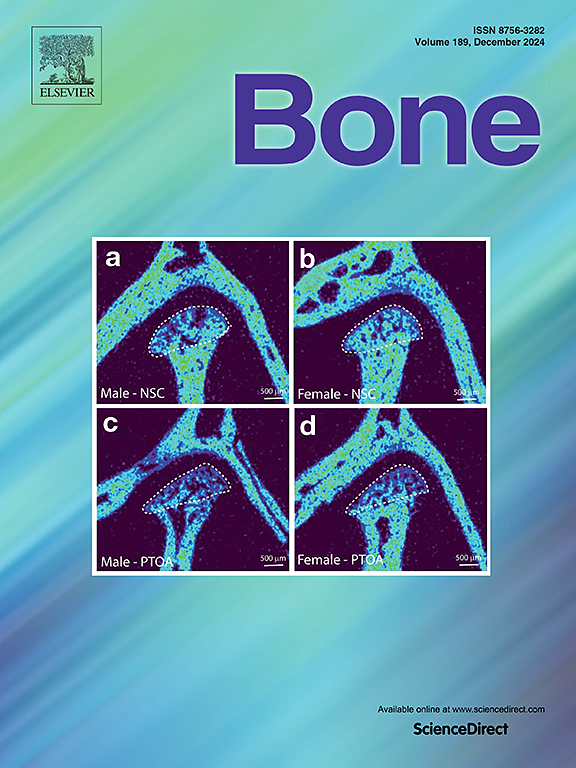孕期暴露于母亲吸烟和终生吸烟:与中年椎体尺寸的关系。
IF 3.6
2区 医学
Q2 ENDOCRINOLOGY & METABOLISM
引用次数: 0
摘要
然而,在怀孕期间暴露于母亲吸烟与骨骼发育呈负相关,一些研究报告没有发现任何结果。后代的吸烟行为也可能与骨骼结构有关。然而,吸烟是否与脊椎大小有关尚不清楚。我们调查了母亲在怀孕期间吸烟或子女从5岁到46岁 终生吸烟是否与中年椎体尺寸有关。来自1966年芬兰北部出生队列的566名后代在46岁 岁时接受了腰椎磁共振成像。资料完整。我们利用先前确定的母亲吸烟轨迹和后代终身吸烟轨迹作为暴露,使用横截面积(CSA)和第四腰椎体积作为研究结果,并将性别、父母的社会经济地位、终生体重指数、终生身体活动和教育作为一般线性模型的潜在混杂因素。与“不吸烟者”相比,“成年晚期戒烟者”的CSA (β [B]系数0.9,95 %置信区间0.4-1.5)和体积(2.2,0.4-4.0)更大。调整后,CSA的B系数减弱,但仍具有统计学意义(0.5,0.1-0.9),而体积的B系数减弱至不显著(0.7,-0.6至2.0)。其他终生吸烟轨迹或母亲在怀孕期间吸烟轨迹与研究结果无关。椎体大小与终生吸烟或母亲在怀孕期间吸烟没有负相关。然而,需要更多的研究和更大的样本和客观暴露数据来证实这些发现。本文章由计算机程序翻译,如有差异,请以英文原文为准。
Exposure to maternal smoking during pregnancy and lifelong smoking: Association with vertebral dimensions in middle age
Exposure to maternal smoking during pregnancy is negatively associated with bone development, however, some studies have reported null findings. Offsprings' smoking behavior may also relate to bone structure. However, it is unclear whether smoking relates to vertebral size. We investigated whether maternal smoking during pregnancy or offsprings' lifelong smoking from ages five years to 46 years is associated with vertebral dimensions in middle age.
A total of 566 offspring from the Northern Finland Birth Cohort 1966 underwent lumbar magnetic resonance imaging at age 46 years. Complete data were available. We utilized previously identified maternal smoking trajectories and offsprings' lifelong smoking trajectories as exposures, used cross-sectional area (CSA) and volume of the fourth lumbar vertebra as study outcomes, and considered sex, parental socioeconomic status, lifelong body mass index, lifelong physical activity, and education as potential confounders in general linear models.
The “late adult quitters” were associated with larger CSA (Beta [B] coefficient 0.9, 95 % confidence interval 0.4–1.5) and volume (2.2, 0.4–4.0) than the “non-smokers.” After adjustments, the B coefficient of CSA attenuated but remained statistically significant (0.5, 0.1–0.9), while the B coefficient of the volume attenuated to non-significant (0.7, −0.6 to 2.0). Other lifelong smoking trajectories or maternal smoking trajectories during pregnancy were unrelated to the study's outcomes. There was no negative association between vertebral size and lifelong smoking or maternal smoking during pregnancy. However, more research with larger samples and objective exposure data is warranted to confirm these findings.
求助全文
通过发布文献求助,成功后即可免费获取论文全文。
去求助
来源期刊

Bone
医学-内分泌学与代谢
CiteScore
8.90
自引率
4.90%
发文量
264
审稿时长
30 days
期刊介绍:
BONE is an interdisciplinary forum for the rapid publication of original articles and reviews on basic, translational, and clinical aspects of bone and mineral metabolism. The Journal also encourages submissions related to interactions of bone with other organ systems, including cartilage, endocrine, muscle, fat, neural, vascular, gastrointestinal, hematopoietic, and immune systems. Particular attention is placed on the application of experimental studies to clinical practice.
 求助内容:
求助内容: 应助结果提醒方式:
应助结果提醒方式:


